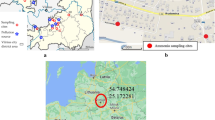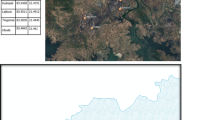Abstract
It may be the first study in Egypt and therein lays the importance of carrying out this study to determine the impact of emissions of such type of power stations on ambient air quality. Survey for four pollutants: suspended particulate matter (SPM), inhalable suspended particulate matter (ISPM), sulfur dioxide (SO2), and nitrogen dioxide (NO2), at the ISCC power plant was achieved in the period from April 2009 to March 2012. The annual levels of SPM were 680.4, 546.7, and 466.2 μg m−3 and those of ISPM were 318.3, 239.2, and 175.6 μg m−3 for years 2009, 2010, and 2011, respectively. The high contribution of SPM and ISPM is due to dust intrusions, besides local sources. Lower ISPM/SPM concentration ratio than 0.5 confirms that desert intrusions are the main source. The annual NO2 levels were 14.2, 17.9, and 19.0 μg m−3 and those of SO2 were 8.1, 10.3, and 8.8 for years 2009, 2010, and 2011, respectively. These concentrations are very low when compared with the Egyptian and international laws but daily SO2 levels exceed the limit given by WHO. This shows the low impact of studied gaseous pollutants. There is no definite seasonal trend for SPM and ISPM in the first and third year of study while SPM level in the second year was high in spring (March and May) and winter (December to February), whereas ISPM concentration was high in spring only (March and May). Coarse particulate matter is predominant in winter. The variation in NO2 and SO2 concentrations changes from year to year of the studied 3 years. The relatively high SO2/NO x ratios indicate that the point emission sources are predominant. Significant relation of WS with SPM and its nonsignificant relation with ISPM reflect the contribution of desert intrusions. Most of pollutants correlations with studied meteorological factors are nonsignificant, and this confirm that the main sources of pollution are local sources.




Similar content being viewed by others
References
Abdel Hameed, A. A., Khoder, M. I., Ibrahim, Y. H., Saeed, Y., Osman, M. E., & Ghanem, S. (2012). Study on some factors affecting survivability of airborne fungi. Science of the Total Environment, 414, 696–700.
Abdel Salam, M. S., & Sowelim, M. A. (1967). Atmospheric Environment, 1(3), 211.
Abdelmaksoud, A.S., (2011). “Study of air pollution in the industrial area of Shaq El-Teeban in Cairo” Ph. D. Thesis, Faculty of Science, Cairo University, Egypt.
Abu-Allaban, M., Lowenthal, D. H., Gertler, A. W., & Labib, M. (2007). Sources of PM10 and PM2.5 in Cairo’s ambient air. Environmental Monitoring and Assessment, 133, 417–425.
Alfaro, S. C., Gaudichet, A., Gomes, L., & Maille, M. (1998). Mineral aerosol production by wind erosion: aerosol particle sizes and binding energies. Geophysical Research Letters, 25, 991–994.
Alghamdia, M. A., Shamy, M., Redalb, M. A., Khoder, M., Awad, A., & Elserougy, S. (2014). Microorganisms associated particulate matter: A preliminary study. Science of the Total Environment, 479–480, 109–116.
Ali, E. A., & Nassralla, M. M. (1990). The 5th International Conference in Indoor Air Quality and Climate: 29 (pp. 323–327). Toronto: Metro Toronto Conversion Center.
Aneja, V. P., Roelle, P. A., Murray, G. C., Southerland, J., Erisman, J., Fowler, D., Asman, W. A. H., & Patni, N. (2001). Atmospheric nitrogen compounds II: emission transport, transformation, deposition and assessment. Atmospheric Environment, 35, 1903–1911.
Athar, M., Ali, M., & Khan, M. A. (2010). Gaseous and particulate emissions from thermal power plants operating on different technologies. Environmental Monitoring and Assessment, 166, 625–639.
Bagnold, R. A. (1941). The physics of blown sand and desert dunes. New York: Methuen.
Basha, S., Gaur, P. M., Thorat, R. B., Trivedi, R. H., Mukhopadhyay, S. K., Anand, N., Desai, S. H., Mody, K. H., & Jha, B. (2007). Heavy metal content of suspended particulate matter at world's largest ship-breaking yard Alang-Sosiya, India. Water Air Soil and Pollution, 178, 373–384.
Dopatka, J., Ford, N., Jiajanpong, K. (2003). Opportunities to achieve improved WFGD performance and economics. In Proceedings of the Combined Power Plant Control Mega Symposium. Washington DC.
Egyptian Environmental Affair Agency (EEAA) Environmental Protection Law No. 4 (1994) amended by the Law No. 9 (2009).
El-Mekawy, A. M. A., (2007). Exposure assessment due to environmental pollution of Helwan City, M. Sc. Thesis, Faculty of Science, Helwan University, Egypt.
Ezzo, A. A., (2005). Effect of industrial emissions on the environment at Sadat City in Egypt, M. Sc. Thesis, Faculty of Science, Cairo University, Egypt.
Gauderman, J. W., Avol, E., Gilliland, F., Vora, H., Thomas, D., Berhane, K., McConnell, R., Kuenzli, N., Lurmann, F., Rappaport, E., Margolis, H., Bates, D., & Peters, J. (2004). The effect of air pollution on lung development from 10 to 18 years of age. The New England Journal of Medicine, 351, 1057–1067.
Goudie, A. S., & Middleton, N. J. (2006). Desert dust in the global system. Heidelberg: Springer Verlag.
Grivas, G., Chaloulakou, A., Samara, C., & Spyrellis, N. (2004). Spatial and temporal variation of PM10 mass concentrations within the greater area of Athens Greece. Water, Air, and Soil Pollution, 158, 357–371.
Grousset, F. E., Ginoux, P., Bory, A., & Biscaye, P. E. (2003). Case study of a Chinese dust plume reaching the French Alps. Geophysical Research Letters, 30, 1277.
Harrison, R. M., & Perry, R. (1986). Handbook of air pollution analysis (2nd ed.). London: Chapman and Hall.
Hassan, S.K.M., (2000). A study on indoor air quality in greater Cairo, M. Sc. Thesis, Faculty of Science, Cairo University, Egypt.
Hassan, S.K.M., (2006). Atmospheric polycyclic aromatic hydrocarbons and some heavy metals in suspended particulate matter in urban, industrial and residential areas in greater Cairo, Ph.D Thesis, Faculty of Science, Cairo University, Egypt.
Hassan, W.H.A., (2006). Size distribution and chemistry of suspended particulate matter (PM10, PM2.5, and less) in Cairo atmosphere, M. Sc. Thesis, Faculty of Science, Ain Shams University, Egypt.
Hindy, K. T., (1977). Types, sources and distribution of dust deposits in the major cities of the Nile valley, Ph.D. Thesis, Faculty of Science, Ain Shams University, Egypt.
Hossny, E., Mokhtar, G., El-Awady, M., Ali, I., Morsy, M., & Dawood, A. (2001). Environmental exposure of the pediatric age groups in Cairo City and its suburbs to cadmium pollution. Science of the Total Environment, 273, 135–146.
Kampa, M., & Castanas, E. (2008). Human health effects of air pollution. Environmental Pollution, 151, 362–367.
Khoder, M.I., (1997). Assessment of some air pollutants in Cairo and their role in atmospheric photochemistry, Ph.D Thesis, Faculty of Science, Ain Shams University, Egypt.
Kim Oanh, N. T., Pongkiatkul, P., Upadhyay, N., & Hopke, P. P. (2009). Designing ambient particulate matter monitoring program for source apportionment study by receptor modeling. Atmospheric Environment, 43, 3334–3344.
Kok, J. F., Parteli, E. J. R., Michaels, T. I., & Karam, D. B. (2012). The physics of wind-blown sand and dust. Reports on Progress in Physics, 75, 106901.
Kouprianov, V. I., Bashkin, V. N., Towprayoon, S., Milindalekha, J., & Wongyai, K. (2002). Emission of arsenic and gaseous pollutants from power generation in Northern Thailand: Impact on ecosystems and human health. World Resource Review, 14, 98–115.
Marticorena, B., & Bergametti, G. (1995). Modeling the atmospheric dust cycle: 1. Design of a soil-derived dust emission scheme. Journal of Geophysical Research, 100, 16,415–16,430.
Miller, S. D., Kuciauskas, A. P., Liu, M., Ji, Q., Reid, J. S., Breed, D. W., et al. (2008). Haboob dust storms of the southern Arabian Peninsula. Journal of Geophysical Research, 113, D01202. doi:10.1029/2007JD008550.
Monn, C. H., Branedi, O., & Schaeppi, C. H. (1995). Particulate matter < 10 μm (PM10) and total suspended particulates (TSP) in urban, rural, and alpine air in Switzerland. Atmospheric Environment, 29(19), 2565–2573.
Nasralla, M.M., (1969). Air contaminates in the industrial area of Helwan, M. Sc. Thesis, Faculty of Science, Ain Shams University, Egypt.
Özden, O., Dogeroglu, T., & Kara, S. (2008). Assessment of ambient air quality in Eskişehir Turkey. Environment International, 34, 678–687.
Pant, P., & Harrison, R. M. (2013). Estimation of the contribution of road traffic emissions to particulate matter concentrations from field measurements: A review. Atmospheric Environment, 77, 78–97.
Prospero, J. M., Barrett, K., Church, T., Dentener, F., Duce, R. A., Galloway, J. N., II, Moody, H. L. J., & Quinn, P. (1996). Atmospheric deposition of nutrients to the North Atlantic Basin. Biogeochemistry, 35, 27–73.
Raizenne, M., Neas, L. M., Damokosh, A. L., Dockery, D. W., Spengler, J. D., Koutrakis, P., Ware, J. H., & Speizer, F. E. (1996). Health effects of acid aerosols on North American children: pulmonary function. Environmental Health Perspectives, 104, 559–579.
Ravi, S., D’Odorico, P., Breshears, D. D., Field, J. P., Goudie, A. S., Kahn, R. A., et al. (2011). Aeolian processes and the biosphere. Reviews of Geophysics, 49, RG3001. doi:10.1029/2010RG000328.
Reddy, G. S., & Ruj, B. (2003). Ambient air quality status in Raniganj-Asansol area India. Environmental Monitoring and Assessment, 89, 153–163.
Robaa, S.M., (2003). Urban-suburban/rural differences over greater Cairo, Egypt. Atmósfera. 157 – 171.
Rodriguez, S., Querol, X., Alastuey, A., & Kallos, G. (2001). Saharan dust contributions to PM10 and TSP levels in Southern and Eastern Spain. Atmospheric Environment, 35, 2433–2447.
Rossli, M., Theis, G., & Kunzli, N. (2001). Temporal and spatial variation of the chemical composition of PM10 at urban and rural sites in the Basel area Switzerland. Atmospheric Environment, 35, 3701–3713.
Salvador, P., Artinano, B., Alonso, D. G., Querol, X., & Alastuey, A. (2004). Identification and characterization of sources of PM10 in Madrid (Spain) by statistical methods. Atmospheric Environment, 38, 435–447.
Schwarze, P. E., Øvrevik, J., Lag, M., Refsnes, M., Nafstad, P., Hetland, R. B., & Dybing, E. (2006). Particulate matter properties and health effects: Consistency of epidemiological and toxicological studies. Human and Experimental Toxicology, 25, 559–579.
Shakour, A. A., Hassanien, M. A., & El-Taieb, N. M. (2001). Journal of Occupational and Environmental Medicine, 7, 3–4.
Shao, Y., Wyrwoll, K. H., Chappell, A., Huang, J., Lin, Z., McTainsh, G. H., et al. (2011). Dust cycle: An emerging core theme in Earth system science. Aeolian Research, 2, 181–204.
Sharma, R., Pervez, Y., & Pervez, S. (2005). Seasonal evaluation and spatial variability of suspended particulate matter in the vicinity of a large coal-fired power station in India—a case study. Environmental Monitoring and Assessment, 102, 1–13.
Song, Z., Wang, J., & Wang, S. (2007). Quantitative classification of northeast Asian dust events. Journal of Geophysical Research, 112, D04211. doi:10.1029/2006JD007048.
Soweliem, M., (1977). Influence of Khamaseen dust storms on dustfall over Cairo. Ph.D. Thesis, Faculty of Science, Cairo University, Egypt.
Stern, A. C. (1968). Air pollution (1st ed., pp. 617–654). New York: Acad. Press.
Stern, B. R., Raizenne, M. E., Burnett, R. T., Jonea, L., Kearney, J., & Franklin, C. A. (1994). Air pollution and childhood respiratory health: exposure to sulphate and ozone in 10 Canadian rural communities. Journal of Environmental Research, 66, 125–142.
Streets, D.G., (1997). Energy and acid rain projections for Northeast Asia. Available as http://www.nautilus.org/archives/papers/energy/streetsESENAY1.html.
Taylor, M. R., Rubin, E. S., & Hounshell, D. A. (2005). Control of SO2 emissions from power plants: A case of induced technological innovation U.S. Technological Forecasting and Social Change, 72, 697–718.
Tomás-Alonso, F. (2005). A new perspective about recovering SO2 off gas in coal power plants: Energy saving: Part III. Selection of the best methods. Journal of Energy Sources, 27, 1051–1060.
USEPA (1971). National ambient air quality standards (www.epa.gov/air/criteria.html), 36 FR 8186 Apr 30, 1971.
USEPA (1987). National ambient air quality standards (www.epa.gov/air/criteria.html), 52 FR 24634 Jul 1, 1987.
USEPA (2012). National ambient air quality standards (www.epa.gov/air/criteria.html).
Weather underground (2015) http://www.wunderground.com, (retrieved on 23/3/2015).
WHO, (2006) Air quality guidelines for particulate matter, ozone, nitrogen dioxide and sulfur dioxide, global update 2005, summary of risk assessment. 1211 Geneva 27, Switzerland: World Health Organization.
World Bank (1998). Pollution prevention and abatement handbook (www.worldbank.org). Ambient air quality in thermal power plants.
Author information
Authors and Affiliations
Corresponding author
Rights and permissions
About this article
Cite this article
Hindy, K.T., Abdelmaksoud, A.S. Air Quality Monitoring Around The First ISCC Power Plant in Egypt. Water Air Soil Pollut 227, 59 (2016). https://doi.org/10.1007/s11270-015-2743-5
Received:
Accepted:
Published:
DOI: https://doi.org/10.1007/s11270-015-2743-5




